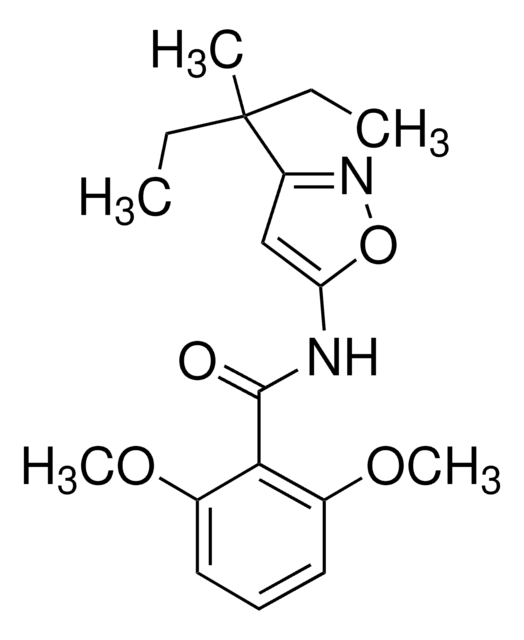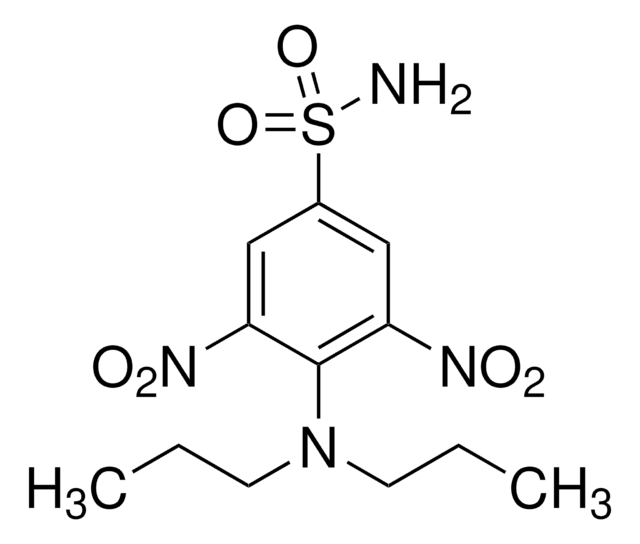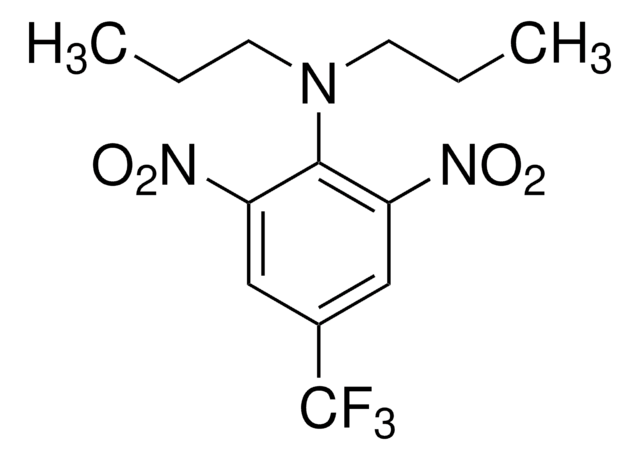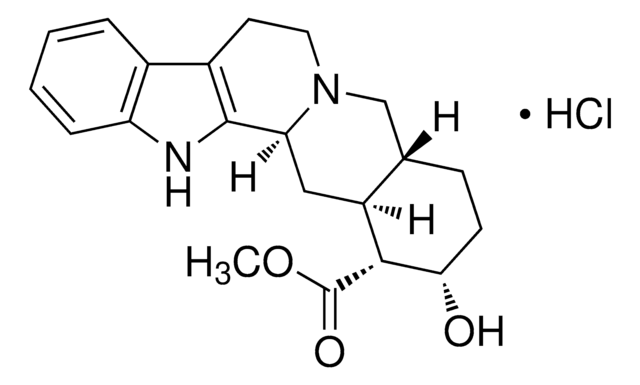75772
Isoxaben
certified reference material, TraceCERT®, Manufactured by: Sigma-Aldrich Production GmbH, Switzerland
About This Item
Produits recommandés
Qualité
certified reference material
TraceCERT®
Niveau de qualité
Gamme de produits
TraceCERT®
Durée de conservation
limited shelf life, expiry date on the label
Fabricant/nom de marque
Manufactured by: Sigma-Aldrich Production GmbH, Switzerland
Format
neat
Température de stockage
2-8°C
Chaîne SMILES
CCC(C)(CC)c1cc(NC(=O)c2c(OC)cccc2OC)on1
InChI
1S/C18H24N2O4/c1-6-18(3,7-2)14-11-15(24-20-14)19-17(21)16-12(22-4)9-8-10-13(16)23-5/h8-11H,6-7H2,1-5H3,(H,19,21)
Clé InChI
PMHURSZHKKJGBM-UHFFFAOYSA-N
Vous recherchez des produits similaires ? Visite Guide de comparaison des produits
Catégories apparentées
Description générale
Isoxaben is a pre-emergence broad-leaf herbicide used primarily on small grains, turf, and ornamentals. This systematic herbicide is absorbed primarily by roots and translocated to stems and leaves. Isoxaben is a highly selective and potent inhibitor of cellulose biosynthesis in plants. It inhibits the incorporation of glucose into the cellulose-rich acid-insoluble fraction of isolated cell walls and disrupts its growth.
Isoxaben is approved for use in European Union (EU) according to Regulation (EC) No 1107/2009 (repealing Directive 91/414/EEC). As per Reg. (EC) No 149/2008, maximum residue levels (MRLs) have been set for various products of plant and animal origin from 0.01 to 0.1 mg/kg.
Application
- To measure the effect of isoxaben on the incorporation of radiolabeled glucose, leucine, uracil, and acetate into acid-insoluble cell wall material, protein, nucleic acids, and fatty acids, respectively, in Arabidopsis thaliana
- To determine the relative toxicities of isoxaben and two of its primary metabolites in soybean and wheat cell cultures
- To investigate the effect of trifluralin, pronamide, haloxyfop-p methyl, propaquizafop, and isoxaben on weed control and oilseed rape yield
- To study the degradation of isoxaben in soil and an aqueous system followed by isolation and identification of degradation products formed
- To examine the effect of four different organic wastes, composted sheep manure, spent coffee grounds, composted pine bark, and coir, on potential groundwater pollution of propanil, isoxaben, cadusafos, and pencycuron under laboratory conditions
Produits recommandés
Informations légales
Mentions de danger
Conseils de prudence
Classification des risques
Aquatic Chronic 4
Code de la classe de stockage
11 - Combustible Solids
Classe de danger pour l'eau (WGK)
WGK 3
Point d'éclair (°F)
Not applicable
Point d'éclair (°C)
Not applicable
Faites votre choix parmi les versions les plus récentes :
Certificats d'analyse (COA)
It looks like we've run into a problem, but you can still download Certificates of Analysis from our Documents section.
Si vous avez besoin d'assistance, veuillez contacter Service Clients
Déjà en possession de ce produit ?
Retrouvez la documentation relative aux produits que vous avez récemment achetés dans la Bibliothèque de documents.
Notre équipe de scientifiques dispose d'une expérience dans tous les secteurs de la recherche, notamment en sciences de la vie, science des matériaux, synthèse chimique, chromatographie, analyse et dans de nombreux autres domaines..
Contacter notre Service technique




